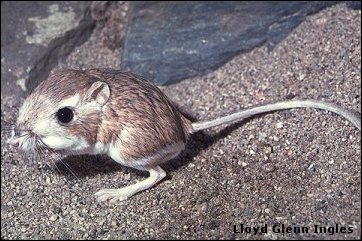 Learning Links:
Learning Links:  Facilitators
Facilitators  Learners
Learners 

Kangaroos are not the only animals with pockets. Three major groups of Chihuahuan Desert rodents sport deep cheek pouches opening to the outside on either side of the mouth.
One group, the pocket gophers, spend almost all of their lives in tunnels in the soil. For food, they depend largely on roots, tubers, and other subterranean goodies that they stuff into their pockets to be carried back to their food stash.
Pocket mice and kangaroo rats, distantly related to the pocket gophers,
have a very different life style. Although they dig burrows for shelter, these
nocturnal rodents depend on surface foraging for seeds, their main food source. In the
desert, seed gathering often means venturing away from protective vegetation into open
areas where small mammals are especially vulnerable to predators, such as owls, coyotes
and foxes. The ability to quickly stuff seeds into their portable storage bins means
minimal exposure before they are able to dart back into relative safety.

Listen to the Audio (mp3 format) as recorded by KTEP, Public Radio for the Southwest.
Contributor: Arthur H. Harris, Laboratory for Environmental Biology, University of Texas at El Paso.
Desert Diary is a joint production of the Centennial Museum and KTEP National Public Radio, University of Texas at El Paso.

Dipodomys merriami. Photographer: Dr. Lloyd Glenn Ingles. Copyright 1999 California Academy of Sciences.
More information on the scientific placement and distribution of Merriam's Kangaroo Rat is given in the Chihuahuan Desert pages.